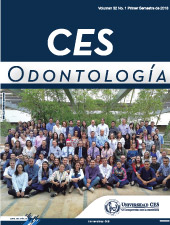Diagnóstico y tratamiento conservador de quiste dentígero: seguimiento a 3 años
DOI:
https://doi.org/10.21615/cesodon.31.1.6Palabras clave:
Quiste Dentígero, descompresión quirúrgica, odontología pediátricaResumen
El quiste dentígero es el quiste de desarrollo odontogénico más común. Aunque puede afectar cualquier diente incluido, los molares y caninos son los más afectados, seguidos por los premolares e incisivos. Este trabajo tiene como objetivo relatar el caso de una paciente de 11 años de edad quien refería ausencia del segundo premolar inferior derecho (45) en el arco dental. De esa manera, se hizo una revisión de literatura abordando el diagnóstico y tratamiento de esta condición. Luego del el exámen clínico y radiográfico se pudo observar una imagen compatible con un de quiste dentígero, cuyo diagnóstico fue confirmado por el examen histopatológico y tomografía computarizada de haz cónico (cone beam). Fue realizado un procedimiento quirúrgico conservador de descompresión utilizando el resultadode la tomografía como guía quirúrgica. Después de 4 meses de seguimientoclínico y radiográfico, se realizó la enucleación de la lesión porcuretaje. Se hizo seguimiento de la paciente durante 3 años hasta la erupcióncompleta del diente 45 y su alineación en el arco. No se observaron lesiones y el tratamiento ortodóntico fue eficaz. La técnica de descompresión quirúrgica fue segura, evitó daños de otras estructuras importantes y proporcionó una rápida recuperación de la paciente.
Descargas
Referencias bibliográficas
Gohel A, Villa A, Sakai O. Benign Jaw Lesions. Dent Clin North Am. 2016; 60(1):125-41.
Devenney-Cakir B, Subramaniam RM, Reddy SM, Imsande H, Gohel A, Sakai O. Cystic and cystic-appearing lesions of the mandible: review. AJR Am J Roentgenol. 2011; 196(6 Suppl):WS66-77.
Daley TD, Wysocki GP. The small dentigerous cyst: a diagnostic dilemma. Oral Surg Oral Med Oral Pathol Oral Radiol Endod. 1995; 79(1):77–81.
Benn A, Altini M. Dentigerous cysts of inflammatory origin: a clinicopathologic study. Oral Surg Oral Med Oral Pathol Oral Radiol Endod. 1996; 81(2):203-9.
Arce K, Streff CS, Ettinger KS. Pediatric Odontogenic Cysts of the Jaws. Oral Maxillofac Surg Clin North Am. 2016; 28(1):21-30.
Arjona-Amo M, Serrera-Figallo MA, Hernández-Guisado JM, Gutiérrez-Pérez JL, Torres-Lagares D. Conservative management of dentigerous cysts in children. J Clin Exp Dent. 2015; 7(5):e671-4.
Asutay F, Atalay Y, Turamanlar O, Horata E, Burdurlu MÇ. Three-Dimensional Volumetric Assessment of the Effect of Decompression on Large Mandibular Odontogenic Cystic Lesions. J Oral Maxillofac Surg. 2016; 74(6):1159-66.
Allon DM, Allon I, Anavi Y, Kaplan I, Chaushu G. Decompression as a treatment of odontogenic cystic lesions in children. J Oral Maxillofac Surg. 2015; 73(4):649-54.
Yahara Y, Kubota Y, Yamashiro T, Shirasuna K. Eruption prediction of mandibular premolars associated with dentigerous cysts. Oral Surg Oral Med Oral Pathol Oral Radiol Endod. 2009; 108(1):28-31.
Song IS, Park HS, Seo BM, Lee JH, Kim MJ. Effect of decompression on cystic lesions of the mandible: 3-dimensional volumetric analysis. Br J Oral Maxillofac Surg. 2015; 53(9):841-8.
Thomas EH. Cysts of the jaws; saving involved vital teeth by tube drainage. J Oral Surg (Chic). 1947; 5(1):1-9.
Naclério H, Simões WA, Zindel D, Chilvarquer I, Aparecida TA. Dentigerous cyst associated with an upper permanent central incisor: case report and literature review. J Clin Pediatr Dent. 2002; 26(2):187-92.
Nakamura N, Mitsuyasu T, Mitsuyasu Y, Taketomi T, Higuchi Y, Ohishi M. Marsupialization for odontogenic keratocysts: Long-term follow-up analysis of the effects and changes in growth characteristics. Oral Surg Oral Med Oral Pathol Oral Radiol Endod. 2002; 94(5):543-53.
Koca H, Esin A. Aycan K. Outcome of dentigerous cysts treated with marsupialization. J Clin Pediatr Dent. 2009; 34(2):165-8.
Peterson LJ, Ellis E III, Hupp JR and Tucker MR. Contemporary Oral and Maxillofacial Surgery. 3rd ed. St Louis: Mosby, 1998. p. 540.
Zhao Y, Liu B, Han QB, Wang SP, Wang YN. Changes in bone density and cyst volume after marsupialization of mandibular odontogenic keratocysts (keratocystic odontogenic tumors). J Oral Maxillofac Surg. 2011; 69(5):1361-6.
Celebi N, Canakci GY, Sakin C, Kurt G, Alkan A. Combined orthodontic and surgical therapy for a deeply impacted third molar related with a dentigerous cyst. J Maxillofac Oral Surg. 2015; 14(Suppl 1):93-5.
Miyawaki S, Hyomoto M, Tsubouchi J, Kirita T, Sugimura M. Eruption speed and rate of angulation change of a cyst-associated mandibular second premolar after marsupialization of a dentigerous cyst. Am J Orthod Dentofacial Orthop. 1999; 116(5):578–84.
Hyomoto M, Kawakami M, Inoue M, Kirita T. Clinical conditions for eruption of maxillary canines and mandibular premolars associated with dentigerous cysts. Am J Orthod Dentofacial Orthop. 2003; 124(5):515-20.
Fujii R, Kawakami M, Hyomoto M, Ishida J, Kirita T. Panoramic findings for predicting eruption of mandibular premolars associated with dentigerous cyst after marsupialization. J Oral Maxillofac Surg. 2008; 66(2):272-6.
Descargas
Publicado
Cómo citar
Número
Sección
Licencia
Derechos de autor 2021 CES Odontología

Esta obra está bajo una licencia internacional Creative Commons Atribución-NoComercial-CompartirIgual 4.0.
| Estadísticas de artículo | |
|---|---|
| Vistas de resúmenes | |
| Vistas de PDF | |
| Descargas de PDF | |
| Vistas de HTML | |
| Otras vistas | |



